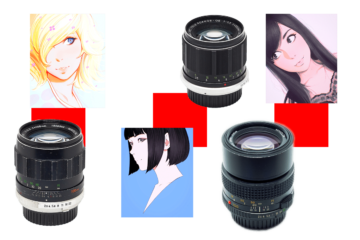Minolta MC Rokkor QE 100mm 1:3.5 Tele – MC I – review

Minolta MC Rokkor QE 100mm 1:3.5 vintage manual lens review (Minolta MC Tele Rokkor-QE 1:3.5 f=100mm )
- Official classification: MC
- Collector’s classification: MC I
This is the final reincarnation number four of Minolta SR-mount 100mm lenses with faster F=3.5. Production started in 1959 (AR-I design by collectors indexing) and finished with this MC-I between 1969-1970.
Since the first test results were obtained I don’t understand – why Minolta stopped to produce it? This lens is one of the biggest sensations since the site was started.

Minolta MC Rokkor QE 100mm 1:3.5 specifications:
| # in minolta.eazypix.de index | 156 |
| Name engraved on the lens | MC TELE ROKKOR-QE |
| f[mm] | 100 |
| A max [1/f] | 3.5 |
| A min[1/f] | 22 |
| Lens design [el.] | 5 |
| Lens design [gr.] | 4 |
| Filter thread Ø front(rear)[mm] | 52 |
| Lens Shade | D52NE |
| closefocus[m/ft] | 1.2/4 |
| Dimension Ø x length [mm] | 63×54 |
| Weight[g] | 240 |
| Year | 1966 |
| Style | MC I |
| Code No. (ROKKOR-X) or Order No. | 668 or 66L |
More Data
| Floating elements | NO |
| Number of aperture blades | 6 |
| Confidence in the test results of reviewed copies | Enough high |
| Reviewed Lens SN: | 1312840 |
Minolta MC Rokkor QE 100mm 1:3.5 exterior:
Minolta MC Rokkor QE 100mm 1:3.5 mounted on the camera Minolta SR-T101
The lens and the camera both from close the same age of design, lens exterior is a little bit older, but this couple is historically appropriate:
Minolta MC Rokkor QE 100mm 1:3.5 lens shade:
Minolta MC Rokkor QE 100mm 1:3.5 sharpness
Сlose-distance resolution test, minimal distance
Testing methods description
- Target: 10-15 cm picture, printed on glossy photo paper
- Distance: 1.7m
- Camera: Sony A7II (24mpx, full-frame, tripod, remote control). M-mode, ISO fixed, WB fixed, SteadyShot – OFF.
- The test was repeated for every F-stop on every focus position with manual focus adjustment for each shot. That is to avoid the effect of field curvature.
- RAW processing: Capture One, default settings. All quality settings – 100%. Crops – 300×200 px
Original target image (printed in horizontal orientation on 10cm X 15cm glossy photo paper)
Scene preview
Test results
Long-distance resolution test
Testing methods description
- Target: cityscape
- Distance: > 200 meters to center focus point
- Camera: Sony A7II (24mpx, full-frame, tripod, remote control). M-mode, ISO fixed, WB fixed, SteadyShot – OFF. The focus point is on the center only.
- RAW processing: Capture One, default settings. All quality settings – 100%. Crops – 300×200 px
Scene preview
Test results
Minolta MC Rokkor QE 200mm 1:3.5 aberrations
Vignetting
Geometric distortion
Coma aberrations
Chromatic aberrations
Long-distance bokeh
Test#1
Test conditions: the lens was focused on 1.2m, buildings are on “infinity”-distance
Test#2
Test conditions: lens was focused on 2.5m
Light bubbles bokeh
Test #1
The lens is on the minimal focusing distance 1.2m, lights are on infinity (cityscape)
Test #2
Test conditions: lens was focused on 2m
Minolta MC Rokkor PE 100mm 1:3.5 final conclusion
Earlier, the central place in the category “Amazing and Forgotten” has been held by Minolta MD 28mm 1:3.5. But today this small princess Rokkor 100/3.5 took the place above. The lens without weaknesses /of course in the borders of characteristics – F3.5 is max/. Just imagine – the faster lenses on these focal distances have existed, but any other of them can be compared with this 100/3.5 on opened F3.5. This is not an exaggeration, proofing comparison tests will be added to the site soon. The lens is absolutely sharp even wide open at F3.5, and finding the difference to the next F5.6 requires a time.
It has no coma. Chromatic aberrations are micro and in corners only – and this is impossible for the tele-lens. It has no noticeable geometric aberrations and shows quite typical vignetting – not heavy at least.
No doubts – bokeh is ‘creme’, with the interesting rendering of ‘sharpness-to-bokeh’ transition zone, which gives a popular 3D-pop effect, it may be not so noticeable as on faster lenses but presented. On portrait distances, this 100mm and F3.5 provide thin DOF which is enough for any photographer task.
240 grams and 63 mm – it doesn’t need a big space in a photographer bag. Or even in a pocket. A great solution for photographers who doubt about to take something long and heavy into the next trip or not.
Add here standard advantages of any old Minolta MC lenses: no rubber, it’s steel and glass only, and construction is quite simple to fix most of the possible issues at home conditions with a screwdriver and hammer /joke/. Without of laboratory, I mean.
I’m glad: it looks like one another gem by Minolta has been found. This is the high-level lens, can be recommended with no doubts.



































3 Comments
hanhasgotqi · 2021-12-01 at 07:22
Hi Tony, thanks for the review. Looks like a great find. Do you know if this MC 100mm f3.5 lens is radioactive? Cheers.
Tony · 2021-12-01 at 12:22
Hi hanhasgotqi, don’t worry – this lens is absolutely clean. Minolta produced very few radioactive lenses, literally only 2 of those that we have a chance to encounter – MC 28mm f2.5 and MC 58mm f1.2, and the latter was radioactive only at the very beginning of production. Reviews of both lenses with details on this subject are available on this site
hanhasgotqi · 2021-12-03 at 09:26
Hi Tony, thanks for the reply. Will check out your reviews.